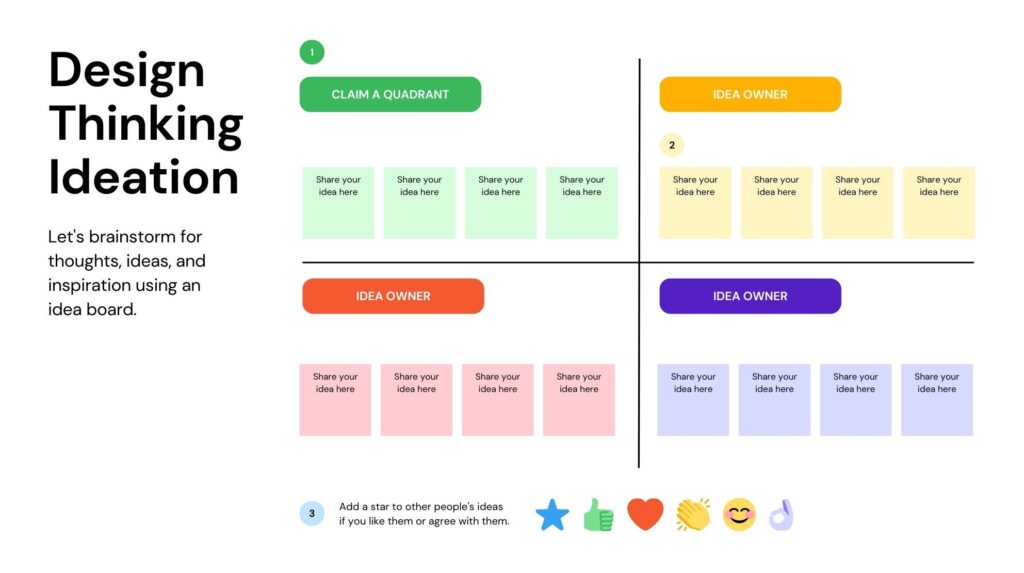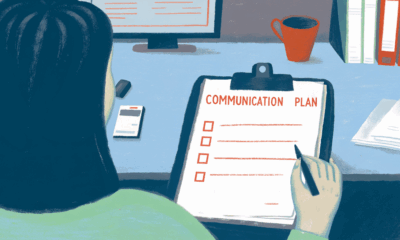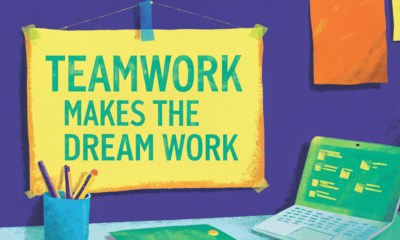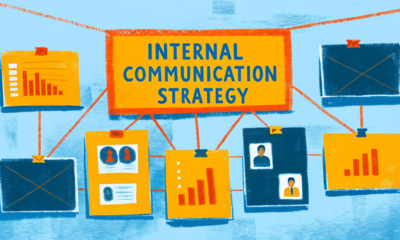Collaboration
11 Brainstorming Tools to Improve Teamwork

Does your small business have remote workers? Or are you allowing your employees to work from home owing to the pandemic?
You are not alone. In fact, 57% of small business owners are considering allowing their employees to work from home post-pandemic.
While doing remote work is achievable and more productive, according to studies, you need to implement some effective brainstorming tools to facilitate creativity and improve teamwork.
But with so many tools out there, it can be difficult to settle for the right tool.
In this article, we will be focusing on 11 brainstorming tools to help you pick the right tool. Your team can use them to improve collaboration, facilitate innovation, and increase productivity.
1. Google Documents
Though popularly used for file sharing, Google Documents can serve as a simple yet useful brainstorming tool for your team.
Since it is shareable, you can create a new doc and share it with your team members, allowing them to edit.
Ideas can be built in real-time while motivating each other. As you can see who is typing what and leave comments, it is very practical. Plus, the Google Documents tool is free.
Have a look at Google Documents’ user interface:
Key Features:
- Suggestion mode – When working on a shared document, Google Doc allows you to change the edit mode and it tracks changes. There is an Accept and Reject button for each comment.
- Voice typing – If you would rather use your voice than type, Google Docs have a voice typing feature. However, note that is presented only in the Chrome browser
- Tag feature – It also has a feature that allows you to tag a person when you want to draw their attention. They will get an email alert.
Platform: Compatible with Windows, macOS, Linux, Chrome OS, and also with mobile platforms. Google Docs apps are accessible for Android and iOS.
Pricing: Google Docs is free to use.
2. Bubbl.us
Using Bubbl.us will make it easier for your team to organize your ideas visually. It is designed to help you stay on task and capture your thoughts instantaneously.
Have a look at Bubbl.us’ user interface:
Apart from brainstorming new ideas, you can take notes, collaborate, and present more effectively.
To collaborate with your teammates, just add the contact/email id.
And click sharing. A menu will pop up.
Click on the mind-map that you want to share and on the contact. You can allow the edit option to let other team members work on mind-map.
Key Features:
- Share and collaborate with others: The intuitive mind-mapping tool allows you to type ideas, plan and manage meetings, and share them with your team members.
- Intuitive interface: You won’t find any difficulty in navigating the tool as the intuitive interface and menus are laid down in a very simple way to meet your expectations.
- Print, save, and share diagrams: It allows you to print the diagrams in docs, save it in different formats such as PNG, HTML, JPG or PDF, and share your work via a link.
Platform: Browser-based – it works the same on mobile as well as on desktop.
Pricing: Bubbl.us offers a free trial and a premium plan at $6 per month.
3. Coggle
With the help of Coggle, you will be able to share complex information clearly. It allows you to share notes quickly and easily and map out processes, systems, and algorithms with the flowcharts, making it perfect for brainstorming.
You can use it online in your browser. It doesn’t require any downloading or installing.
Key Features:
- Collaborative and interactive app: It supports real-time collaboration. You can invite other team members to work on diagrams all at the same time. You can also share a secret link with your team members where they can make edits without logging in.
- Mind-mapping and flow-charting made easy: You can upload unlimited images to the online diagram using its drag-and-drop feature. You can also join branches and design loops to represent process flows. Plus, it allows you to add floating text labels and images to explain parts of the map.
Platform: It works online in your browser and offers support for desktop, tablet, and mobile interfaces.
Pricing: Coggle offers three pricing plans:
- Freemium: $0 – it offers 3 private diagrams, including limitless public diagrams, core features, and shared folders.
- The Awesome plan: $5 per month – includes additional offers like unlimited private diagrams, high resolution image uploads, and collaboration via a link.
- The Organization plan: $8 per member per month – gives you all features you get in the Awesome plan. Additionally, you get features like bulk export, separate personal workspace, user and data management, and more.
4. WiseMapping
You can use this free java-based tool online or install it on your server to collaborate on mind maps. It has cool features, including customizable fonts and colors and icons.
When you are done building your mind maps, you can export it or embed it from WiseMapping on your blog. The tool integrates with LDAP to secure your data.
Here’s WiseMapping’s user interface:
Key Features:
- Complete mapping features: WiseMapping comes with varied tools that can create maps that reflect the users’ thoughts. The drag-and-drop interface is easy to use and you can freely move objects around and rearrange your diagrams on the platform.
- Public and personal workspaces: WiseMapping allows a private mind mapping environment for personal ideas. But you can also use the public mapping feature and invite other team members.
- Flexible: Though WiseMapping is originally designed for the web, you can also install it on the organizations’ servers and distribute them within their system securely.
Platform: Compatible with all modern browsers, including Microsoft Internet Explorer 8 and above, Firefox 12 and above, Google Chrome 19 and above, Safari 5 and above, and Opera 11 and above.
Pricing: WiseMapping is a free tool.
5. LucidChart
A visual workspace that enables diagramming, collaboration, and data visualization, using LucidChart will accelerate understanding and boost innovation.
It is an intuitive, cloud-based solution that allows you to collaborate in real-time and allows you to create whiteboard, brainstorm, or build flowcharts, UML diagrams, and mockups, among others.
Here’s what LucidChart’s user interface looks like:
Key Features:
- Easily style shapes: LucidChart makes it super easy to style shapes as it gives you the option to choose the font, size, color, and line style before you drag any shapes on the canvas. After that, the styling you choose will be automatically applied to the shapes you drag and drop on the canvas.
- Expandable canvas: With Lucidchart’s one-click solution, you can expand the canvas and make big diagrams when required.
- Keep diagrams organized with containers: You can keep your diagrams organized and easy to read by using containers or swimlanes features.
- Collaborate and get feedback: Once you create your diagram, you can collaborate without leaving the platform. There is a commenting feature where your team can leave comments on specific shapes or the document as a whole.
Platform: Lucidchart is compatible with Mac, PC, Linux, iOS, and Android operating systems.
Pricing: Lucidchart offers four pricing plans:
- Freemium: It’s a free plan.
- The Individual Plan: Starts at $7.95. With this plan, you get unlimited editable documents, 1000+ professional templates, and more.
- The Team Plan: Starts at $6.67 per user. It can be used by 3 users minimum and you will get to enjoy advanced collaboration and integration features.
- The Enterprise Plan: Quote-based plan.
6. Milanote
If your business needs to create high-quality documents fast with ease while collaborating with multiple contributors, this tool is for you. It is a great organizing tool where you can bring your best ideas and see them grow.
Many use this tool for group brainstorming as it allows you to see what other team members are working on and make comments.
Its drag-and-drop interface will allow you to arrange images, notes, links, files, videos, and tasks on a virtual canvas. Plus, all the content you place in Milanote will be synced to the cloud.
Key Features:
- Easy to use drag and drop interface – With Milanote’s drag and drop interface you can easily arrange things in a way that best suits your project.
- Shared workspace – You can either use Milanote’s boards to think privately or use it as a shared workspace for collaboration.
- Edit in real-time – You will be able to see the changes your team makes and leave comments. It also offers smart notifications and alerts so you won’t miss a thing.
- Share the result – When everything is done, you can invite your team members to view and edit your boards. You can also download a high-quality printable PDF.
Platform: It is compatible with iPhone, Mac, Windows, and Chrome and Safari browsers.
Pricing: Milanote offers two plans:
- Freemium Plan: A free pricing plan which offers features like sharing unlimited boards, adding 100 notes, images or links, and uploading 10 files.
- The Professional Plan: Priced at $9.99 per month per person billed annually and $12.50 when billed monthly. You will get everything on the free plan, unlimited notes, images, and links, upload unlimited files, and search board and content.
7. Miro
Miro features a versatile virtual whiteboard with which you can conduct remote brainstorming. You will get a lot of pre-built templates and sticky notes.
Here’s Miro’s user interface:
You will be able to easily import images, PDF, keynotes, PowerPoint files, and more. After you are done, you can export the board and share it with your team.
The tool can be integrated with Slack and other instant messaging apps.
Key Features:
- Zoomable canvas and whiteboard: With Miro’s infinitely zoomable canvas and web whiteboard, you can unleash your creativity, plan projects from different angles, and create centralized hubs of information keeping everyone in the loop.
- Extensive Integration: The tool can be integrated with Slack, Dropbox, Box, Google Suite, and other instant messaging apps.
Platform: It is compatible with PCs and laptops, iPad, Windows, or Android Tablet.
Pricing: Miro offers four pricing plans:
- Free: With Miro’s free plan, you can avail features including 3 editable boards, premade templates, and core integrations.
- The Team Plan: $8 per month. It provides features like unlimited boards, unlimited external board viewers and commenters, and advanced attention management.
- The Business Plan: $16 per month. It comes with features like Single Sign-On (SSO), day passes for occasional collaborators, external editors, and more.
- The Enterprise Plan: Custom plan.
8. Mural
A digital workspace for visual collaboration, Mural can help you to think and collaborate visually while solving important problems. You can create diagrams fast and with ease, and there are tools to facilitate meetings and workshops.
Have a look at Mural’s user interface:
Moreover, its sticky notes feature will allow you to organize lists, flowcharts, diagrams, frameworks, methods, and drawings.
Key Features:
- Collaborate visually – Mural helps your team to think and collaborate visually to solve problems.
- Enjoy speed and ease of use – You can benefit from Mural’s speed and ease of use while creating diagrams.
- Thinking canvas – You can put your thoughts on sticky notes and organize in lists, flowcharts, diagrams, frameworks, methods, and drawings.
- Visual teamwork – Have impactful meetings and workshops. Enjoy shared workspaces, remote facilitation features, conduct expert coaching and education, and more.
Platform: It supports browsers including Chrome, Edge, Firefox and Safari. The apps support Windows10, iOS, and the Microsoft Surface Hub.
Pricing: Mural offers three pricing plans:
- The Starter Plan: $12 per membership/month. It will give you access to collaboration in a single workspace, unlimited visitors, library of frameworks and templates, and more.
- The Plus Plan: $20 per membership/month. It offers features like unlimited guests, SAML or oAuth2 single-sign-on, priority support, and more.
- The Enterprise Network Plan: It offers customized pricing.
9. Whatfix
Considered the biggest WalkMe alternatives out there, Whatfix is a training tool that any business can use with ease. It allows you to adjust to your users’ onboarding needs.
Its real-time, in-app help is customized to individual roles. And the tool adds context and relevance to a learner’s experience, making the training more effective.
What’s more? You can hold brainstorming sessions with managers and get valuable insights from them.
Key Features:
- Offer a superior user experience – You can adjust to your users’ onboarding needs and offer personalized journeys.
- Real-time in-app help – Use Whatfix’s real-time in-app help that is customized to individual roles.
- Offer on-the-job learning – Your training will be more effective when you add context and relevance to a learner’s experience offered by Whatfix.
Platform: It supports mobile devices and browsers, including Firefox, Chrome, Internet Explorer, Edge, Safari, and Opera.
Pricing: You can request a custom pricing quote.
10. Otter.ai
You can use this AI-powered tool Otter for brainstorming, generating notes for meetings, interviews, or voice conversations.
Their new release, Otter 2.0, comes with more functionality to increase collaboration and productivity. The Teams plan has features designed especially for SMBs and teams in larger enterprises.
Key Features:
- Create rich notes – You can create rich notes for meetings, interviews, lectures, and other voice conversations.
- Make fast, accurate transcriptions – You can make fast, accurate transcriptions with Otetr.ai. It also offers speaker identification and streamlined management tools.
- Enjoy more functionality with Otter 2.0 – The new Otter 2.0 will give you improved collaboration and productivity.
Platform: It supports Google Chrome (version 67 or higher), Safari (version 11 or higher), Firefox (version 59 or higher), and Edge (version v80 or higher). The mobile app supports iOS and Android. Plus, it works with Zoom meetings.
Pricing: Otter offers three pricing plans:
- The Basic Free Plan: $0. It offers many core features including record and playback, transcribe in real-time, search by keywords, and more.
- The Premium Plan: $8.33 per month. It offers all the premium features like import audio and video, advanced export, custom vocabulary, and more.
- The Teams Plan: $20 per month. It offers advanced features like Otter live notes for Zoom, team vocabulary, time codes, centralized billing, and more.
11. Canva Online Whiteboard
People are discovering new ways to work together online and accomplish goals as remote work quickly spreads throughout society. When you and your team are bringing your ideas to life, Canva’s Online Whiteboard makes it enjoyable and simple to workshop, brainstorm, collaborate on an endless canvas, and see each other’s contributions as they happen.
Have a look at Canva Online Whiteboards’ user interface:

Key Features:
- Unlimited space for unlimited ideas: infinite canvas on Canva Whiteboards, you have all the room you need to unleash your best ideas.
- Collaborate with ease: Invite the entire team to work on your design and easily collaborate in real time
- Customizable charts and tables: Data visualization made easy. Easy flowcharts with features like Quick Flow, Connecting Lines, and Shapes
- Extensive library: Hundreds of templates with popular use cases
Platform: It works online in your browser, and Canva App, and offers support for desktop, tablet, and mobile interfaces.
Pricing: Free
Wrapping Up
There you have it, 11 brainstorming tools that you can start using right away to improve teamwork. Brainstorming and collaborating is crucial as it boosts your critical thinking and problem-solving skills as a team.
However, in order to do that while working remotely, you need essential tools that can allow sharing your innovative ideas with ease. To get the most out of your sessions, keep these points in mind:
- Ensure that the tools you choose are easy to navigate and can record ideas while you share them.
- Good brainstorming tools also allow users to vote or comment on ideas, helping to prioritize and organize effectively.
- Start your session with a clear goal or question to keep everyone focused.
- Use built-in templates in your chosen tool to add structure and save time.
- Capture everything — use tools like Otter.ai for transcription or Google Docs for note-taking alongside visual aids like sticky notes or diagrams.
- Encourage free idea flow with visuals, sketches, or voice notes, depending on your tool.
- Group and prioritize ideas using color coding, clustering, or voting features that many tools offer.
- Wrap up by summarizing key takeaways, assigning next steps, and sharing outcomes directly from your brainstorming board or document.
- Save your setup as a reusable template to streamline future sessions.
The tools mentioned in this article are some of the best tools that you can implement to boost your creativity and be more productive. Start using them today to see positive results.
Collaboration
The Power of Collaboration: Exploring the Dynamics of Group Coaching

The working world is changing. And employees know that. But what’s changing goes beyond the ever-growing debate of whether employees should physically return to their workplace.
With the growth of Artificial Intelligence (AI) tools, workplaces are adapting to accommodate the need for new skills, demonstrating the necessity for professional development and coaching in the workplace.
While some may believe AI removes positions, it’s doing the opposite. It’s created jobs and skill sets that haven’t existed before, forming a new landscape for the digital world. The problem isn’t that AI is taking jobs, but that workers are not yet ready for the roles that AI has created.
According to the University of Phoenix’s Annual Career Optimism Index of 2022, 40% of those surveyed said they “worry their job skills will become outdated because of advancements in technology such as automation, artificial intelligence, and robots.” These workers know that the time for upskilling is now. More than half of those surveyed said they must learn new skills within the next year to continue their careers.
And they want to work with employers that recognize that need and offer opportunities to challenge themselves and help them step into the newly-created roles. 68% of those surveyed said they would stay with their employer throughout their career if the employer provided opportunities to upskill.
Professional development is essential for retention, but it’s costly and intimidating for workers.
What is group coaching, and why does it work? Let’s get into how this form of coaching can help your staff upskill.
What is group coaching?
Unsplash.com
Group coaching is a type of professional development where a coach works with a small group to help them learn new skills and reach their goals. During one-on-one coaching, only one employee works with the coach and receives their attention. With group coaching, all members have a common goal. The coach may set aside time to work with each member individually, but they generally meet and work as a group.
What does group coaching look like?
Group coaching can look different depending on the environment. For example, outside the workplace, you may see group coaching as an online course where one coach works through presentations and provides activities to their subscribers.
Group coaching may be more nebulous, with a larger group of people working through the content on a website and coming together to chat about the work, with the content’s creator chiming in to assist.
But in the workplace, group coaching typically involves one expert guiding a group of coworkers through lessons. If you work in an office setting, you might set aside a standard meeting time when the coach and group members can meet in person. Or, if you’re remote, you might set up a video call for presentations and use team collaboration tools to work on activities together.
Ultimately, the main aspect of a group coach that’s always necessary is that everyone in the group is working toward a common goal. That goal helps guide the creation and focus of the coach’s presentations and activities.
Group coaching may be for one team at a time. For example, you might have your company’s teams work in a separate group coaching session. But because group coaching centers around a common goal, you may find that cross-team group coaching is just as beneficial, if not more.
You can survey your employees about what skill sets they want to work on and create groups for coaching based on their answers. This step can help you harness more diverse skill sets on each team and encourage cross-team collaboration.
What are the benefits of group coaching?
1. Prevents silos
Your company is looking to adopt a new AI tool. You have assigned one person as the expert on the application. They know all the ins and outs of how to use it.
But that one expert is the only person who knows how to use it. As a result, the rest of your employees continue to work on more time-consuming processes without realizing how the AI tool could benefit them.
Without realizing it, you’ve created a knowledge silo. Unfortunately, silos are a common part of many workplaces. In addition to knowledge silos, you may also have data silos. One team may store their essential data using one application, while another group may keep theirs somewhere else. All the while, they may not realize that they could benefit from each other’s information. The lack of oversight over each other’s data may also diminish the information’s quality. If these teams aren’t working together, your company may not be using the data optimally.
Group coaching can help stop silos in their tracks. By putting together a group of people who want to reach common goals, you can help them develop essential skills that benefit the whole company.
If you pulled together a group to learn how to use the new AI tool, you would no longer have the issue of just one person who could utilize it. Ultimately, you would save time and resources by allowing more company members to access a tool that would make processes more manageable.
Organizing your group coaching around a common goal rather than simply creating groups according to teams can also facilitate more learning throughout your company. For example, if someone from your marketing, customer success, sales, and software design teams wanted to learn how to use the AI tool, they could bring those learnings back to their groups, spreading the knowledge and further helping the company.
2. Allows collaboration and learning from each other
An expert is an essential part of group coaching. But the group doesn’t just benefit from one person. They also learn from each other.
The coach isn’t just a coach. They are also facilitators. They may teach the group as experts, but they also should facilitate discussions among the group and create activities to promote collaboration.
Say you organized a group coaching session for your newest sales representative. You should develop activities such as researching prospects and developing lead-generation strategies together. In addition, you might have them practice sales calls with each other.
While the coach may be able to offer guidance, the reality is that every person in the group also has something to offer. Each comes with their own experience and background, which they can use to assist each other.
Perhaps one sales representative learned a great tip about engaging a potential customer from their previous company’s sales team lead. They can bring that strategy into the discussion, which their fellow sales representatives can use during their sales calls.
Beyond their experience, working as a team can also help each other see different points of view and learn different problem-solving techniques. For example, if someone struggles to understand a concept, another group member may hold the key to offering an explanation they can comprehend.
3. Develops camaraderie
Beyond collaboration, group coaching also helps coworkers develop trust in each other. By working towards a common goal, the group members can learn who their coworkers are. Ultimately, the time spent together helps them see each other in a new light.
This new camaraderie is an especially valuable part of cross-team group coaching. Generally, a sales team member is likely to spend more time with someone on their team than someone on another team. As a result, most meetings they attend will be with their group; they likely sit around people who also do sales; and they generally know their team dynamics better than their other coworkers.
While doing cross-team group coaching is one way to help prevent silos, it’s also beneficial for developing camaraderie across your company. Trust and fellowship create a healthier, happier, and ideal work environment where people feel listened to and supported, even beyond their team’s boundaries.
4. Diminishes intimidation
No one knows all the answers. But a part of coaching is questioning your employee and asking them to think about solutions. In addition, you want them to develop their problem-solving skills, which means that you can’t just provide them with answers all the time.
But being questioned one-on-one can be intimidating and the opposite of what you want from professional development. You want your employee to come out of professional development feeling more confident and ready to tackle new challenges. But not knowing the answers during one-on-one questioning may make them feel less self-assured.
Group coaching prevents all the attention from falling on one person. During individual coaching, the one person receiving the coaching may get their coach’s undivided attention, but that’s not always a good thing. In a group setting, each member won’t feel they need to know all the answers. They can offer solutions, but they can also spend time listening to coworkers’ responses.
Listening is also part of what makes group coaching so beneficial. By hearing their coworkers’ thought processes, they can develop their listening and retention skills, while also honing the skills they initially came to group coaching to form. And because they’ll feel less intimated, they can focus more on the task rather than being stuck in their heads.
5. Fosters a culture focused on learning
By investing in group coaching, you’re showing your employees that you care about their growth. In a time when people are greatly concerned about upskilling, you want to create a workplace where your employees know that they will continue to advance their skills and, therefore, their careers.
By fostering a culture of learning, you’re demonstrating to your employees that you value them and want to help them face the challenges that may arise as the working world adapts to new tools and technologies. In addition, as the modern working world changes, legacy positions may become obsolete.
But new roles will replace them. Upskilling is one part of the puzzle, but so is reskilling, as your employees may need to develop entirely new skill sets for these roles. Rather than hiring new workers, you can invest in your current employees’ future through professional development, like group coaching.
Your employees want to learn, so it’s up to you to provide them with opportunities. Group coaching helps you develop a company filled with employees honing their skill sets, both professionally and interpersonally. These group members learn from their coach, but they also learn from each other. When you make learning a part of your company values through group coaching, you’re setting your company and each worker up for success.
Are you ready to pump up your group coaching?
Employees are looking to upskill right now. And they’re willing to look for companies that offer the opportunity to develop new skills if their current employer doesn’t.
If you want to retain quality workers, you have to retrain them. With the digital landscape changing constantly, the modern workforce requires new skills.
Investing in professional development is vital to keeping your employees feeling supported, but group coaching goes beyond professional development. With group coaching, you can train more people at once and allow them to learn from an expert in the skill set they want to develop.
Some of the key benefits of group coaching include:
- Preventing silos by sharing knowledge and tools across departments
- Encouraging collaboration through shared experiences
- Strengthening communication, including listening, feedback, and problem-solving skills
- Building camaraderie by connecting people across teams and roles
- Reducing pressure, as group settings often feel less intimidating than one-on-one coaching
- Creating a culture of learning that signals your investment in employee growth
- Promoting skill transfer as new knowledge spreads organically within teams
- Boosting engagement and retention by helping people grow where they work
Beyond skills, group coaching fosters interpersonal connections and breaks down barriers between departments, helping to build a more cohesive and confident workforce.
Through working with new people, you can also help cut down on the development of silos throughout your company. And by using group coaching instead of one-on-one coaching, you can also keep the intimidation levels down, making your employees better, more confident learners.
Learning is precisely what you want to keep at the forefront of your company’s culture. Your employees want to learn. And they want to know that you care about developing their skills and knowledge. A learning culture benefits every aspect of your company and makes your business more likely to be ready to embrace whatever the future holds. As long as you offer opportunities to keep learning and growing through professional development, like group coaching, you’ll be able to prepare your employees for every challenge that comes their way.
Collaboration
18 Experts Share Tips for Businesses Switching to Remote Work

The world is going through a lot right now, with the current outbreak of the coronavirus. Lots of things changed in recent weeks, and most prominently, a lot of companies switched to working remotely. While remote work is far from a novelty, many companies are now giving it a go for the first time just now.
To help out everyone who is dipping their toes in remote working, we’ve gathered a few remote work experts to provide their insights and answer one question:
What is your best piece of advice for companies who are just starting with remote work?
Here are their thoughts.
18 Experts share tips for businesses switching to remote work
DMYTRO OKUNYEV — Founder of Chanty
” It’s essential that you promote a healthy lifestyle, as difficult as that may be. You should be setting time to exercise for all your team members to keep them in shape. There are plenty of benefits to exercising, including improving your overall health.
If you want your team to feel good and perform well, you need them to be healthy and rested so that they can work effectively.
I like to lead by example, so I work out every morning. “
ADAM HEMPENSTALL — CEO and Owner, Better Proposals
” Focus on goals rather than time spent working. The great thing about remote work is that you don’t need to work 8 hours per day.
Instead, give each of your employees a goal and make sure they stick to their outcome. As long as the goal is completed, their work is done for the day. “
MAKSYM BABYCH — CEO at SpdLoad
” The more structured and transparent your processes are, the more rapid your growth is.
It is a huge business advantage to have processes that help your team members hit their goals without undue control. “
MELANIE AMINI — Marketing Director at ScholarshipOwl
” Other than the internet and tech support, it is the most important to have firm, written boundaries for working hours.
Before the WFH life begins, you must set the number of hours they must be online and rules/best practices to follow, but you must also trust your employees.”
KEVIN INDIG — VP SEO & Content at G2.com and Founder of kevin-indig.com
” Do a virtual standup. My teams and I share our top 3 tasks for the day to create alignment and connect. It doesn’t have to be a video call and it doesn’t have to be that long. Just a quick update.
The cool part is that this helps you to focus on what success looks like. It’s not just for others but also yourself. “
KENNY TRINH — CEO of Netbooknews
” Nothing is more important to remote team communication than the team’s digital inbox. Without the ability to have organic, in-person interactions, employees can easily fall victim to “out of sight, out of mind.”
Thus, it’s critical to create a tech stack that provides multiple avenues for communication. “
SHAWN BREYER — Owner of Atlanta House Buyers
” Each week, a full team meeting should be held to review the KPIs of each member.
It makes them feel like they are accountable and they see how other team members should be performing. If there are people who aren’t getting results, the team needs to discuss if it is goal, team or resources related.
When that person or the team finds if the trend is that no one ever meets their goals, the leadership needs to determine if people are lacking training and resources or if they are not a good fit for the team.“
DARREN VIRASSAMMY — Co-Founder and COO, 34 Strong
” Make sure to have your 1-1s with each team member. Use this disruption as a chance to pause, evaluate what really matters, and grow as a manager. Each shift has to get the team focused on what’s still strong.
There’s an opportunity to realign the team’s work with core values. It’s a chance to strengthen the rhythm for completing work and keeping team members engaged during these unprecedented times. “
CATHY DECKER — Co-founder and Principal Decker/Royal
” Don’t micro-manage, don’t call unexpectedly to time how long it takes to answer the phone, and don’t plan unnecessary meetings. Hold your team members accountable to their deliverables, and then allow them to do their jobs. “
ANH TRINH — Managing Editor, GeekWithLaptop
” Ask an experienced co-worker to show the ropes to the rest of the team. Having someone who knows the ins and outs of the remote work environment can quickly instruct members on how to work properly and productively within a week or so is a great way to get started. “
BRET BONNET — Co-Founder/President, Quality Logo Products
” Be ready to work twice as hard. Make as many team projects as possible, even if they don’t have to be. The more opportunities to work together, the less likely team members are to feel disconnected and the more productive they’ll be! “
MONICA EATON-CARDONE — Co-Founder and COO, Chargebacks911
” Make sure that any individual working from home feels supported. It’s important to remember that even though your employees are not physically in the office, the communication line ought to remain open. “
KATARZYNA IWANICH — Co-Founder, Insightland
” Keep a written agenda such as online schedule with a list of online meetings and tasks for specific days. It helps to plan your job and be efficient in time management.
At the same time, if the team gets stuck with some part of the process, working with deadlines gets easier. “
MARK WEBSTER — Co-Founder, Authority Hacker
” The first thing to do is to get everyone aligned to a strict “communication time.” The thing is, distractions are normal at home.
It’s important to synchronize and have a non-stop 8–10 AM slot every day (or week, whatever suits your team) for the team to be online, available and present for anything that occurs on a day to day basis. “
BEN TAYLOR — Founder, Home Working Club
” My main piece of advice is to trust your team and don’t introduce rules for the sake of it. If you’ve recruited and managed people well, trust shouldn’t be an issue.
Some excuses are generated reasons for things like enforcing instant logins or using screen monitoring software. DON’T DO THESE THINGS.”
ANGELA PEACOCK — CEO, PDT Global
” Recognize that the fears of your employees may not be the same as yours. While you are worried about productivity and how to keep your business alive through this strange time, some of your staff might be worried their children won’t get into school shot during the next year. Others among them may also be anxious about whether the technology is going to let them down and they won’t be able to work. “
JARRED KESSLER — CEO and Founder, EasyKnock
” Use the time to exercise your brain and your health. It’s a huge stress reliever and keeps your immune system boosted.
Go outside if you live alone and pick up the phone if you live with others. If you interact with a loved one once a week at a minimum, you keep your brain more alive than ever. Ask them how they are doing live.”
TAPAN PATEL — Co-founder, Third Rock Techno
” For a smooth transition to a culture of remote working, facilitate time communication. Ensure that your team is equipped with a proper computer and high-speed internet at home.
Help them get all the resources they need to collaborate with each other efficiently. Clearly explain to the team the processes that you plan to follow while everyone is working remotely. “
Conclusion
If you and your company are new to remote work, don’t get scared away by the few challenges it has. Instead, focus on the many positives and you will see that you and your company can be just as productive when working remotely, if not even more. If you have any tips besides the one shared above, please share them with us in the comments to this post.
Collaboration
4 Common Problems of Virtual Teams are Solved

Low-stress level, no commute, no shoes, PJs only, spending more time with family and friends, and so much more. Sounds neat right? According to some studies, remote work has brought higher productivity and a more positive work-life balance since the beginning of the pandemic. However, it’s not all rainbows and butterflies, is it? We have been facing some challenges, to say the least. We struggle with unplugging ourselves once the work is done for the day, we need our office gossip, and even though we don’t need to wear shoes, we still kinda miss them. Many problems can appear when we are managing virtual teams. However, does that mean we cannot ace a video meeting or have the same level of communication with our teammates as we did before? Never! All we have to do is get our hands to the right collaboration tools to manage our virtual teams. I give to you the solutions to the most common problems we’ve faced working from home. Trust me, it really is as easy as pie!
1. Communication breakdown: it’s not all about messages — it’s about meaning
The one most reported problem of remote teams is communication — or the lack of it. But it has nothing to do with missed messages. It has everything to do with lost context.
When you communicate face-to-face, 70–90% of what you intend is communicated through body language, tone of voice, and facial expressions. Remote workers lack that level. An urgent message meant to be productive will be cold. A wait in responding will be perceived as not caring.
That’s why business communications tools like Chanty, Google Chat, and GoToMeeting aren’t nice-to-haves, they’re must-haves. They facilitate teams to communicate in real-time, clarify their communication, and utilize richer media like voice and video. Still, the best tool is nothing without a shared communication culture.
HR comes into play here. Get teams to figure out how they communicate: messaging vs. meeting, how they handle urgency, and what “offline” means. Prioritize making voice notes and camera-on calls the new normal to bring back that human feel.
Communication isn’t only about words. It’s about being heard — and feeling connected.
2. Collaboration without clarity: the hidden cost of scattered work
In an office, things naturally tend to overlap. You stretch over a desk. You cut off someone at the coffee machine. You interpret a face at a brainstorming session.
In virtual teams, it doesn’t happen. And without the proper tools, folks will naturally feel like they’re working in solitude — despite being part of a team.
This is where Google Workspace, Microsoft 365, Dropbox, and OneDrive come in. These apps are not simply storage devices — they create a virtual workspace where collaborators can work together. Teams can work together on docs, comment in real-time, and have one source of truth.
But what really matters is psychological safety. If employees don’t feel free to give each other working drafts or ask for help, technology can’t fix that. HR leaders must create a space where collaboration means learning alongside one another, not just working alongside one another.
Technology reduces the friction. But humans reduce the fear. That’s how collaboration thrives.
3. Remote project confusion: why visibility matters more than ever
Without structure, remote projects can drift. Deadlines are missed. Jobs get blurry. Team members do not know what others are doing — or what they must do.
Project management tools like Asana, Jira, Basecamp, and SmartTask bring much-needed discipline. They break goals into doable pieces. They delegate tasks. They provide timelines and certainty.
But aside from task management, these sites are emotional clarity tools. When everyone can see who’s working on what, stress goes down. Nobody feels like they’re doing it all themselves. Nobody feels ignored. Transparency is peace of mind.
For HR, it’s a golden opportunity. Utilize these tools not just for productivity — but for inclusion. A reserved junior team member during meetings can spring to life when they are given clear guidance in a task board. A mute struggler might reveal to us their stress in overdue assignments.
Project management tools have secrets. Savvy HR teams listen intently.
4. Time and productivity tracking: from surveillance to self-awareness
Time tracking is one of the more controversial aspects of remote work. Done badly, it’s intrusive. Done well, it’s an amazing wellness and performance tool.
TimeDoctor, Hivedesk, Toggl, and PomoDone are some of the applications that enable teams to see how they spend their time. They show data on attention, idleness, and task-switching. To remote teams, this isn’t accountability — it’s awareness.
Most remote workers struggle to “switch off.” They work longer, take shorter breaks, and quietly burn out. HR can use time-tracking data not as a punisher, but as a protector. Recognizing overwork early is an act of care.
Furthermore, these tools empower people. People can look at when they’re most productive, or where they drift off course. They can set their own schedules, and build better habits.
The true value isn’t in tracking time — it’s in getting time to work more effectively for individuals.
Final Thought
No matter how many tools you bring on board, virtual teams will fail if their human needs are not met. The need to connect. To be seen. To understand. To trust.
Which makes HR’s role so critical. You’re not just choosing software —you’re developing culture. When you combine great tools with compassionate leadership, you don’t just solve issues — you create an environment where remote doesn’t equal removed.
Because in the end, remote teams don’t succeed because of technology.
They succeed because they care.
-

 Communication3 months ago
Communication3 months ago6 Communication Plan Templates With Examples
-

 Collaboration3 months ago
Collaboration3 months ago6 Tips for Lifting the Burden of Too Many Responsibilities
-

 Collaboration2 months ago
Collaboration2 months ago30 Work From Home Memes: Funny Work Memes to Make You Laugh
-

 Collaboration4 months ago
Collaboration4 months ago35+ Collaboration Quotes to Celebrate Teamwork
-

 Collaboration3 months ago
Collaboration3 months agoThe Definitive Guide to Creating an Internal Communication Strategy
-

 Productivity2 months ago
Productivity2 months agoSuper True Mental Health Memes You’ll Probably Relate To
-

 Collaboration3 months ago
Collaboration3 months ago7 Easy Strategies for Effective Team Communication
-

 Productivity3 months ago
Productivity3 months agoWhat is Imposter Syndrome and How to Overcome It?










